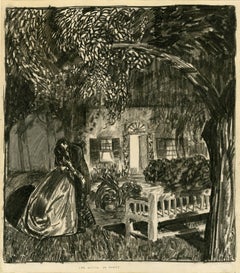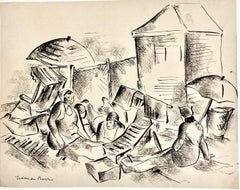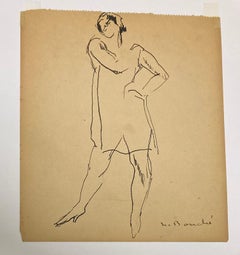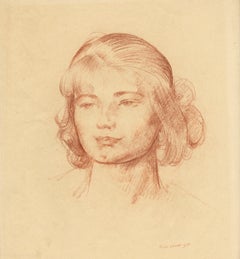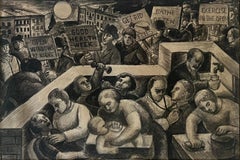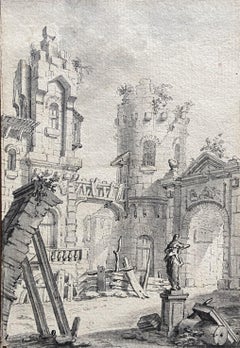Ashcan School Figurative Drawings and Watercolors
to
3
14
4
2
Overall Width
to
Overall Height
to
1
18
1
1
4
5
5,036
3,384
584
383
263
248
211
210
164
150
56
50
48
43
12
7
1
17
11
9
8
5
2
2
2
2
1
1
1
1
1
1
1
1
1
6
5
5
4
4
2
1
1
1
1
3
20
Style: Ashcan School
The Mouth of Honey
Located in Fairlawn, OH
The Mouth of Honey
Lithographic crayon and mixed media on paper mounted to support paper
Initialed by the artist "GB" bottom center on image. (see photo)
Titled in pencil in bottom m...
Category
1920s Ashcan School Figurative Drawings and Watercolors
Materials
Crayon
Norman Barr, Coney Island (large), 1940
By Norman Barr
Located in New York, NY
Norman Barr recorded his beloved New York City from the Bronx, to Coney Island, to the Fulton Fish Market.
In this period he was on the New Deal's Mural ...
Category
Mid-20th Century Ashcan School Figurative Drawings and Watercolors
Materials
Crayon, India Ink
Norman Barr, Delancey Street (NYC)
By Norman Barr
Located in New York, NY
Norman Barr recorded his beloved New York City from the Bronx, to Coney Island, to the Fulton Fish Market.
In this period he was on the New Deal's Mural ...
Category
Mid-20th Century Ashcan School Figurative Drawings and Watercolors
Materials
Crayon, India Ink
Andrée Ruellan, Spring on Bleecker Street (Greenwich Village, NY), drawing 1938
Located in New York, NY
Spring, Bleecker Street, Ruellan's conté crayon drawing from 1938, shows young people out in the world. And their world is Bleecker Street, New York City. The heart of Greenwich Vil...
Category
1930s Ashcan School Figurative Drawings and Watercolors
Materials
Crayon
Louis Bouché, (Standing Woman)
By Louis Bouché
Located in New York, NY
Louis Bouché was based in New York and taught at the Art Students League. The figure was an important subject in his oeuvre. An ink drawing on tan paper, ...
Category
Early 20th Century Ashcan School Figurative Drawings and Watercolors
Materials
Ink
Head of a Woman (Margaret)
By Leon Kroll
Located in Fairlawn, OH
Head of a Woman (Margaret)
conte on wove paper, 1925
Signed and dated lower right
Annotated "Margaret" in ink verso
A portrait of Margaret Cassidy Manship ( d. 2012), daughter in law...
Category
1920s Ashcan School Figurative Drawings and Watercolors
Materials
Conté
red ballboy or Studies for "Tennis Tournament"
Located in Fairlawn, OH
Red Ballboy or Studies for "Tennis Tournament"
Crayon on paper, c. 1920
Unsigned
Condition: three vertical folds created by the artist to transport the drawing from the tennis match ...
Category
1910s Ashcan School Figurative Drawings and Watercolors
Materials
Graphite
Paul Gattuso, (Italian Street Scene - Light)
Located in New York, NY
Paul Gattuso attended the Art Students League and worked primarily in New York City. There is an old address with a Bronx, Grand Concourse address.
Gattus...
Category
1930s Ashcan School Figurative Drawings and Watercolors
Materials
Monotype
Paul Gattuso, (Italian Street Scene)
Located in New York, NY
Paul Gattuso attended the Art Students League and worked primarily in New York City. There is an old address with a Bronx, Grand Concourse address.
Gattus...
Category
1930s Ashcan School Figurative Drawings and Watercolors
Materials
Monotype
Paul Gattuso, (Young Woman)
Located in New York, NY
Paul Gattuso attended the Art Students League and worked primarily in New York City. There is an old address with a Bronx, Grand Concourse address.
Gattus...
Category
1930s Ashcan School Figurative Drawings and Watercolors
Materials
Monotype
Dorothy Varian, Witness
Located in New York, NY
Dorothy Varian (1895-1985) was based in New York City and Woodstock, NY. This is a courtroom scene that captures the intensity of the situation. It is s...
Category
Mid-20th Century Ashcan School Figurative Drawings and Watercolors
Materials
Pencil
Fulton St. Fish Market, Crating (NYC)
By Norman Barr
Located in New York, NY
Born in Czarist Russia Norman Barr (1908-1994) came to New York as a young boy and except for a few night classes at the school of the National Academy of ...
Category
Mid-20th Century Ashcan School Figurative Drawings and Watercolors
Materials
India Ink
Norman Barr, Coney Island (New York City)
By Norman Barr
Located in New York, NY
An idyllic scene at New York City's favorite beach, Coney Island. Before the year was over Barr was in the Army.
It is ink and litho-crayon. Barr liked that medium because it didn't ...
Category
Mid-20th Century Ashcan School Figurative Drawings and Watercolors
Materials
Mixed Media
Battle Scene, Spanish American War
Located in Greenwich, CT
Francis Luis Mora was considered one of America's finest "sketchers". A collection of his Sketchbooks are at the Smithsonian and this work came out of one in the early 1990's from t...
Category
1890s Ashcan School Figurative Drawings and Watercolors
Materials
Graphite
$1,040 Sale Price
20% Off
”Admiring the Picture”
Located in Southampton, NY
Very well executed original gouache on archival paper by the well known American artist Benjamin Kopman. The scene depicts three figures admiring a picture. Signed lower left. Circa ...
Category
1930s Ashcan School Figurative Drawings and Watercolors
Materials
Gouache, Archival Paper
$1,120 Sale Price
20% Off
Norman Barr, Farm, North Bronx (NYC)
By Norman Barr
Located in New York, NY
Norman Barr recorded his beloved New York City from the Bronx, to Coney Island, to the Fulton Fish Market.
In this period he was on the New Deal's Mural ...
Category
Mid-20th Century Ashcan School Figurative Drawings and Watercolors
Materials
Crayon, India Ink
A Pair of Framed Monkey Studies
Located in Buffalo, NY
A pair of exquisite drawings by American Ashcan School artist Alexander Oscar Levy.
Category
1920s Ashcan School Figurative Drawings and Watercolors
Materials
Archival Paper, Graphite
$1,800 Sale Price
25% Off
"Musical Conductor" Amy Londoner, Ashcan School, Figurative Concert Scene
By Amy Londoner
Located in New York, NY
Amy Londoner
Musical Conductor, 1922
Signed and dated lower right
Pastel on paper
Sight 18 x 23 inches
Amy Londoner (April 12, 1875 – 1951) was an American painter who exhibited at the 1913 Armory Show. One of the first students of the Henri School of Art in 1909. Prior to the Armory Show of 1913, Amy Londoner and her classmates studied with "Ashcan" painter Robert Henri at the Henri School of Art in New York, N.Y. One notable oil painting, 'The Vase', was painted by both Henri and Londoner.
Londoner was born in Lexington, Missouri on April 12, 1875. Her parents were Moses and Rebecca Londoner, who moved to Leadville, Colorado, by 1880. In 1899, Amy took responsibility for her father who had come to Los Angeles from Leadville and had mental issues. By 1900, Amy was living with her parents and sister, Blanche, in the vicinity of Leadville, Denver, Colorado. While little was written about her early life, Denver City directories indicated that nineteenth-century members of the family were merchants, with family ties to New York, N.Y. The family had a male servant. Londoner traveled with her mother to England in 1907 then shortly later, both returned to New York in 1909. Londoner was 34 years old at the time, and, according to standards of the day, should have married and raised a family long before. Instead, she enrolled as one of the first students at the Henri School of Art in 1909.
At the Henri School, Londoner established friendships with Carl Sprinchorn (1887-1971), a young Swedish immigrant, and Edith Reynolds (1883-1964), daughter of wealthy industrialist family from Wilkes-Barre, PA. Londoner's correspondence, which often included references to Blanche, listed the sisters' primary address as the Hotel Endicott at 81st Street and Columbus Avenue, NYC. Other correspondence also reached Londoner in the city via Mrs. Theodore Bernstein at 252 West 74th Street; 102 West 73rd Street; and the Independent School of Art at 1947 Broadway. In 1911, Londoner vacationed at the Hotel Trexler in Atlantic City, NJ. As indicated by an undated photograph, Londoner also spent time with Edith Reynolds and Robert Henri at 'The Pines', the Reynolds family estate in Bear Creek, PA.
Through her connections with the Henri School, Londoner entered progressive social and professional circles. Henri's admonition, phrased in the vocabulary of his historical time period, that one must become a "man" first and an artist second, attracted both male and female students to classes where development of unique personal styles, tailored to convey individual insights and experiences, was prized above the mastery of standardized, technical skill. Far from being dilettantes, women students at the Henri School were daring individuals willing to challenge tradition. As noted by former student Helen Appleton Read, "it was a mark of defiance,to join the radical Henri group."
As Henri offered educational alternatives for women artists, he initiated exhibition opportunities for them as well. Troubled by the exclusion of work by younger artists from annual exhibitions at the National Academy of Design, Henri was instrumental in organizing the no-jury, no-prize Exhibition of Independent Artists in 1910. About half of the 103 artists included in the exhibition were or had been Henri students, while twenty of the twenty-six women exhibiting had studied with Henri. Among the exhibition's 631 pieces, nine were by Amy Londoner, including the notorious 'Lady with a Headache'. Similarly, fourteen of Henri's women students exhibited in the groundbreaking Armory Show of 1913, forming about eight percent of the American exhibitors and one-third of American women exhibitors. Of the nine documented works submitted by Londoner, five were rejected, while four pastels of Atlantic City beach scenes, including 'The Beach Umbrellas' now in the Remington Collection, were displayed.
Following Henri's example, Londoner served as an art instructor for younger students at the Modern School, whose only requirement was to genuinely draw what they pleased. The work of dancer Isadora Duncan, another artist devoted to the ideals of a liberal education, was also lauded by the Modern School. Henri, who long admired Duncan and invited members of her troupe to model for his classes, wrote an appreciation of her for the Modern School journal in 1915. She was also the subject of Londoner's pastel Isadora Duncan and the Children: Praise Ye the Lord with Dance. In 1914, Londoner traveled to France to spend summer abroad, living at 99 rue Notre Dames des Champs, Paris, France. As the tenets of European modernism spread throughout the United States, Londoner showed regularly at venues which a new generation of artists considered increasingly passe, including the annual Society of Independent Artists' exhibitions between 1918 and 1934, and the Salons of America exhibition in 1922. Londoner also exhibited at the Morton Gallery, Opportunity Gallery, Leonard Clayton Gallery and Brownell-Lambertson Galleries in NYC. Her painting of a 'Blond Girl' was one of two works included in the College Art Associations Traveling Exhibition of 1929, which toured colleges across the country to broad acclaim.
Londoner later in life suffered from illnesses then suffered a stroke which resulted in medical bills significantly mounting over the years that her old friends from the Henri School, including Carl Sprinchorn, Florence Dreyfous, Florence Barley, and Josephine Nivison Hopper, scrambled to raise funds and find suitable long-term care facilities for Londoner. Londoner later joined Reynolds in Bear Creek, PA. Always known for her keen wit, Londoner retained her humor and concern for her works even during her illness, noting that "if anything happens to the Endicott, I guess they will just throw them out." Sprinchorn and Reynolds, however, did not allow this to happen. In 1960, Londoner's paintings 'Amsterdam Avenue at 74th Street' and 'The Builders' were loaned by Reynolds to a show commemorating the Fiftieth Anniversary of the Exhibition of Independent Artists in 1910, presented at the Delaware Art Center, Wilmington, DE. In the late 80's, Francis William Remington, 'Bill Remington', of Bear Creek Village PA, along with his neighbor and artist Frances Anstett Brennan, both had profound admiration for Amy Londoner's art work and accomplishments as a woman who played a significant role in the Ashcan movement. Remington acquired a significant number of Londoner's artwork along with Frances Anstett Brenan that later was part of an exhibition of Londoner's artwork in April 15 of 2007, at the Hope Horn...
Category
1920s Ashcan School Figurative Drawings and Watercolors
Materials
Paper, Pastel
Third Man 2, black and white, night scene, cityscape
By Tom Bennett
Located in Brooklyn, NY
Dramatic imagery from FILM NOIR series of black and white monotypes, blending surreal mindscapes with stark realism
About Tom Bennett:
With quick brushstrokes, Tom Bennett creates r...
Category
2010s Ashcan School Figurative Drawings and Watercolors
Materials
Archival Paper, Monotype
Head Study, 1930
By John Sloan
Located in Missouri, MO
Head Study, 1930
John Sloan (1871-1951)
Signed Lower Right
10.5" x 9" Unframed
19" x 16.5" Framed
Born in Lock Haven, Pennsylvania, John Sloan became one o...
Category
Early 20th Century Ashcan School Figurative Drawings and Watercolors
Materials
Paper, Conté
Price Upon Request
Related Items
"Good Health Week" American Scene Modern Social Realism Mid 20th Century WPA Era
By Jo Cain
Located in New York, NY
"Good Health Week" American Scene Modern Social Realism Mid- 20th Century WPA Era
Jo Cain (1904 – 2003)
Good Health Week – b/w
10 ½ x 15 1/2 inches
I...
Category
1930s Ashcan School Figurative Drawings and Watercolors
Materials
Paper, Ink
18th Century School, Courtyard of a palazzo, Architectural Capriccio, drawing
Located in Paris, FR
18th Century french School,
Courtyard of a ruined palazzo, An Architectural Capriccio,
Pen and black ink and black ink wash on paper
17 x 12 cm
In good condition
Framed : 32 x 26 c...
Category
1780s Ashcan School Figurative Drawings and Watercolors
Materials
Ink
Illustration of a Village by the River - Amate Bark Drawing in Ink
Located in Soquel, CA
Illustration of a Village by the River - Amate Bark Drawing in Ink
Illustration with people in a village by Cristino Florez Medina (Mexican, 1937-2007). This piece is divided horizo...
Category
Late 20th Century Ashcan School Figurative Drawings and Watercolors
Materials
India Ink, Handmade Paper
$780 Sale Price
35% Off
H 24 in W 30 in D 0.25 in
Buongiorno Professore! - Mixed Media by Sirio Pellegrini - 1969
Located in Roma, IT
Pastel and watercolor drawing on paper realized by Sirio Pellegrini in 1960s.
Very good condition. Hand signed in pencil lower right.
Includes a contemporary wooden frame 108.5x84....
Category
1960s Ashcan School Figurative Drawings and Watercolors
Materials
Pastel, Watercolor
$2,847
H 29.53 in W 16.93 in D 0.4 in
MB 827 (Contemporary Life Drawing of Two Nude Males by Mark Beard)
By Mark Beard
Located in Hudson, NY
Academic life drawing of two nude males with charcoal and graphite by Mark Beard, "MB 827"
graphite, Conte crayon and charcoal on Arches paper
29.75 x 21.75 inches unframed
Signed, l...
Category
2010s Ashcan School Figurative Drawings and Watercolors
Materials
Conté, Charcoal, Archival Paper, Graphite
$1,650
H 29.75 in W 21.75 in
MB 018 (Figurative Life Drawing of Handsome Male Nude by Mark Beard)
By Mark Beard
Located in Hudson, NY
Academic life drawing of male nude with charcoal and graphite by Mark Beard, "MB 018"
graphite, Conte crayon and charcoal on Arches paper
30 x 19 inches unframed
Signed, lower right
...
Category
2010s Ashcan School Figurative Drawings and Watercolors
Materials
Conté, Charcoal, Archival Paper, Graphite
$1,650
H 30 in W 19 in
Figure Drawing by Mark Beard (Stoic, Muscular Male Nude Charcoal Life Drawing)
By Mark Beard
Located in Hudson, NY
Academic life drawing of male nude with charcoal and graphite by Mark Beard
graphite, Conte crayon and charcoal on Arches paper
30 x 19.5 inches unframed
Signed, lower left
Strong f...
Category
2010s Ashcan School Figurative Drawings and Watercolors
Materials
Conté, Charcoal, Archival Paper, Graphite
Contemporary Drawing "The essential". Pastel, Ink And Colored Pencils
Located in Bogotá, Bogotá
Drawing based on natural pigments from leaves, flowers and bark and Pastel, Pencil, flower petals, Color and Ink on Paper. In my work there is a cross with the gaze of animals, a rem...
Category
2010s Ashcan School Figurative Drawings and Watercolors
Materials
Oil Pastel, Ink, Pencil, Color Pencil, Paper
MB 824 (Double-Sided Figure Drawing of Handsome Nude Men by Mark Beard)
By Mark Beard
Located in Hudson, NY
Figurative, academic style life drawing of male nude with charcoal and graphite by Mark Beard, "MB 824"
graphite, Conte crayon and charcoal on Arches paper
30.5 x 21 inches unframed
...
Category
2010s Ashcan School Figurative Drawings and Watercolors
Materials
Conté, Charcoal, Archival Paper, Graphite
Illustration of the Garden of Eden- Amate Bark Drawing in Ink
Located in Soquel, CA
Illustration of the Garden of Eden done with Mexican Amate Bark Drawing in Ink
Vibrant illustration with Adam and Eve in the Garden of Eden by Cristino Florez Medina (Mexican, 1937-...
Category
Late 20th Century Ashcan School Figurative Drawings and Watercolors
Materials
India Ink, Handmade Paper
$780 Sale Price
35% Off
H 18 in W 26 in D 0.25 in
18th Century Roman School , A Palazzo with antiques, drawing
Located in Paris, FR
18th Century Roman School
A Palazzo with antiques
Brown ink and pen, brown ink wash on paper
12.5 x 20 cm
Framed : 28,5 x 35.5
This nice drawing represents a genre scene, with a nobleman, priests, a mother and her children...
Category
Early 18th Century Ashcan School Figurative Drawings and Watercolors
Materials
Ink
"My Fair Lady" 1958 West End Theatre Costume Drawing Mid 20th Century Modern
By Cecil Beaton
Located in New York, NY
"My Fair Lady" 1958 West End Theatre Costume Drawing Mid 20th Century Modern
Cecil Beaton (1904 – 1980) "My Fair Lady," Pen and ink on paper. ...
Category
1950s Ashcan School Figurative Drawings and Watercolors
Materials
Paper, Ink, Pen
$20,000
H 21 in W 19 in D 2 in
Previously Available Items
"Reclining Nude" Everett Shinn, Figurative Woman Watercolor, Ashcan School
Located in New York, NY
Everett Shinn
Reclining Nude, 1940
Signed and dated lower left
Watercolor on paper
4 1/2 x 9 inches
Provenance:
Christie's New York, Interiors, August 28, 2012, Lot 181
Private Collection
Everett Shinn, a future member of the Eight and remarkable, rather theatrical personality was born at Woodstown, New Jersey in 1873. Even more recent sources give 1876 as the year of Everett Shinn's birth but the artist usually lied about his age to appear younger than he actually was. Edith DeShazo claimed that information from family members established the date of November 6, 1876 as Shinn's birthday. But if this is true, he would have enrolled at the Spring Garden Institute in Philadelphia to study industrial art at the age of twelve. Born to a Quaker named Isaiah Conklin Shinn and Josephine Ransley Shinn, Everett was their third child. He enjoyed a happy childhood as an undisciplined boy fond of sweets, acrobatics, and the circus.
Shinn opted for the Pennsylvania Academy of the Fine Arts for instruction in the fall of 1893, and began as a staff artist for the Philadelphia Press. At that time William Glackens was working there as well, while John Sloan was at the Inquirer. A year later, Glackens was at the Press, and also, in 1894, George Luks joined the staff there. As DeShazo explained, "the Press art department became a meeting place for men both on the staff and off with similar artistic and literary interests." Members of the same group also met at Robert Henri's studio. By 1897, Shinn was in New York, working for the New York World where Luks had been for about a year. The rest of the "Philadelphia Four" would follow them before long.
Shinn spent much of 1898 hounding the offices of Harper's until finally, the editor and publisher, Colonel George Harvey saw his portfolio, then commissioned a view of the Old Metropolitan Opera House in a snowstorm. The pastel appeared about a year later in the February 17th issue of Harper's Weekly, in 1900. Meanwhile, Shinn kept busy with decorative work (murals, screens, and door panels) at private residences and even in Trenton, New Jersey's City Hall. In 1899, the Boussod-Valadon Galleries gave Shinn his first one-man show. He continued to carry out commissions for illustrations. Shinn began exhibiting at the Pennsylvania Academy (1899-1908) and at the Art Institute of Chicago (1903-43).
A trip to Europe is documented in 1900 by an exhibition at Goupil's in Paris and by various drawings of Paris...
Category
1940s Ashcan School Figurative Drawings and Watercolors
Materials
Paper, Watercolor
"Street Fair” William Glackens, Ashcan School, Street Scene, Carnival, Boxing
Located in New York, NY
William Glackens
Street Fair, circa 1905
Pencil, ink and gouache on paper
10 x 14 inches
Provenance:
The artist
Kraushaar Galleries, New York
Estate ...
Category
Early 1900s Ashcan School Figurative Drawings and Watercolors
Materials
Paper, Ink, Gouache, Pencil
James Penney, New York From Central Park
By James Penney
Located in New York, NY
James Penney was widely known for his New Yorker covers as well as his paintings and prints.
Penney was from Saint Joseph, Missouri. He trained i...
Category
Mid-20th Century Ashcan School Figurative Drawings and Watercolors
Materials
Watercolor
"Flower Girl, " John George Brown, Genre Painting, Street Figure
Located in New York, NY
John George Brown (1831 - 1913)
Flower Girl, circa 1900
Watercolor on paper
6 3/4 x 4 3/4 inches
Signed lower left
Period Hand Carved Foster Brothers Fram...
Category
Early 1900s Ashcan School Figurative Drawings and Watercolors
Materials
Paper, Watercolor
"Street Scene, Paris, France" Jerome Myers, Ashcan School Drawing
By Jerome Myers
Located in New York, NY
Jerome Myers (1867 - 1940)
Street Scene, Paris, France, 1914
Black crayon and gray wash on paper on card stock
14 x 10 1/8 inches
Signed, titled and dated lower left
Provenance:
Private Collection, New York
Born in Petersburg, Virginia in 1867, Myers became an important painter of urban realism, starting with a series of images of ghetto life in 1887, the year he began studying at the Cooper Union. One of his earliest works is Backyard from that year, in a private collection, which already shows a raw, unidealized view of New York City. Thus he actually anticipated the productions of the Ashcan School. Myers continued his studies at the Art Students League where his teacher was George de Forest Brush, the academic painter of idealized Native Americans. Brush's classicism did not rub off on Myers, who had no patience for careful drawing - he was even disturbed by the presence of a studio model, so he completed a series of self-portrait drawings to satisfy the faculty's requirements. For Myers, the academic experience was too imitative, however he stayed around for eight years. Like artists of the Ashcan School, Myers went directly to the streets of New York for inspiration. He carried a 9" x 11" sketch pad wherever he went, like a "day and night prowler...
Category
1910s Ashcan School Figurative Drawings and Watercolors
Materials
Crayon, Ink, Cardboard
Ink Drawing Painting Train Lines Social Realist WPA Artist Gregorio Prestopino
Located in Surfside, FL
Gregorio Prestopino (1907–1984) Italian American artist. New York Figurative Expressionism.
Ink on paper depicting a lone figure in the foreground walking near trains lines with a train trestle...
Category
20th Century Ashcan School Figurative Drawings and Watercolors
Materials
Paper, Ink
Louis Bouché, (Seated Woman)
By Louis Bouché
Located in New York, NY
Louis Bouché was based in New York and taught at the Art Students League. The figure, and nudes especially, were an important subject in his oeuvre. The d...
Category
Early 20th Century Ashcan School Figurative Drawings and Watercolors
Materials
Pencil
Sleepwalk Redux #6, mysterious monochromatic, dark, lone figure, urban night
By Tom Bennett
Located in Brooklyn, NY
Monotype on paper
Category
2010s Ashcan School Figurative Drawings and Watercolors
Materials
Paper, Monotype
Fantastic Ashcan School Portait Boxer 19th Century Framed American NYC Sporting
Located in Buffalo, NY
A late 19th Century pastel painting of a boxer posing in his red robe.
A common theme for the Ashcan School, this fantastic portrait capt...
Category
Late 19th Century Ashcan School Figurative Drawings and Watercolors
Materials
Paper, Pastel
Fulton St. Fish Market, Weighing (NYC)
By Norman Barr
Located in New York, NY
Born in Czarist Russia Norman Barr (1908-1994) came to New York as a young boy and except for a few night classes at the school of the National Academy of ...
Category
Mid-20th Century Ashcan School Figurative Drawings and Watercolors
Materials
India Ink
Man with Cigar
By Katherine Schmidt
Located in New York, NY
Katherine Schmidt's Man with Cigar is pure 'Fourteenth Street School.' As a very young woman she attended the Art Students League in New York City ev...
Category
1930s Ashcan School Figurative Drawings and Watercolors
Materials
Ink
Orphan, mysterious surrealistic narrative monochromatic black and white noir
By Tom Bennett
Located in Brooklyn, NY
Monotype on paper
Dramatic imagery from Tom Bennett’s series of black and white monotypes, blending surrealistic mindscapes with stark realism
About Tom Bennett:
With quick brushstr...
Category
2010s Ashcan School Figurative Drawings and Watercolors
Materials
Monotype, Paper, Archival Ink, Archival Paper
Ashcan School figurative drawings and watercolors for sale on 1stDibs.
Find a wide variety of authentic Ashcan School figurative drawings and watercolors available for sale on 1stDibs. Works in this style were very popular during the 21st Century and Contemporary, but contemporary artists have continued to produce works inspired by this movement. If you’re looking to add figurative drawings and watercolors created in this style to introduce contrast in an otherwise neutral space in your home, the works available on 1stDibs include elements of orange and other colors. Many Pop art paintings were created by popular artists on 1stDibs, including George Wesley Bellows, Louis Bouché, Everett Shinn, and Benjamin Kopman. Frequently made by artists working with Paper, and Ink and other materials, all of these pieces for sale are unique and have attracted attention over the years. Not every interior allows for large Ashcan School figurative drawings and watercolors, so small editions measuring 7.75 inches across are also available. Prices for figurative drawings and watercolors made by famous or emerging artists can differ depending on medium, time period and other attributes. On 1stDibs, the price for these items starts at $300 and tops out at $55,000, while the average work sells for $1,160.
